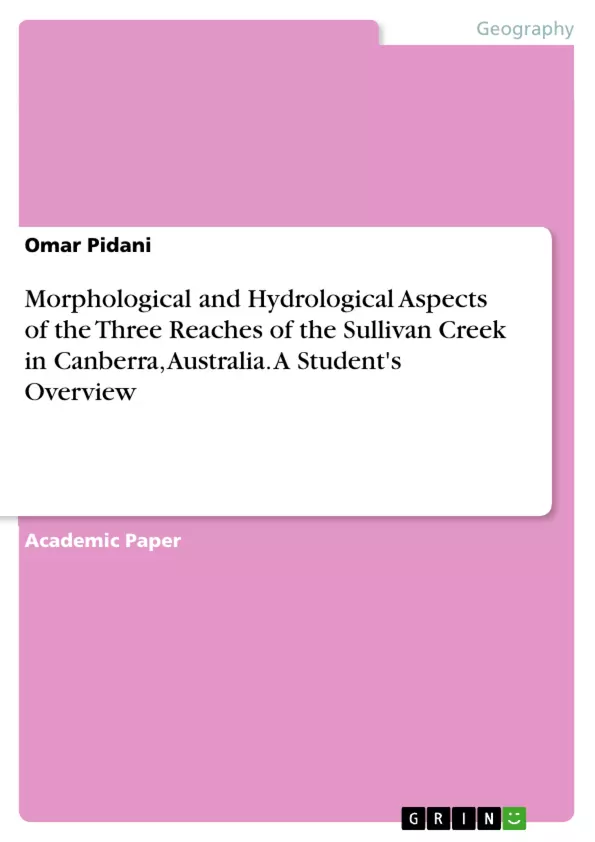This field report was conducted in 2008 as part of the requirements for hydrology and natural resource management course offered at the Fenner School of Environment and Society and is aimed at describing the morphological and hydrological features of several reaches of the Creek at that time.
This study is aimed at familiarizing students with sampling techniques for water quality and stream flow (inclusive flow velocity), and analysis of the data collected. The main objectives of this field observation are:
To assess the stream condition based on its water quality and loading ability of the stream.
To understand various factors that may contribute to the water quality (physical, biological and chemical properties) and stream flow (surface flow, base flow, vegetative covers, anthropogenic factors, channel, shape and structure, etc)
To compare water quality parameters in the 3 reaches, namely at constructed and instream wetland at David Street O’Connor, the concrete line section from David Street wetlands to Barry Drive Gross Pollutant Trap (GPT) and the earthen channel from Barry Drive to Lake Burley Griffin.
Inhaltsverzeichnis (Table of Contents)
- Introduction
- General Description of Sullivan Creek and Catchment
- Previous Studies
- Aim and Objectives of the Study
- Aim
- Objectives
- Study Sites
- Description of the Sites
- Type and Form of Channel
- Bed Materials
- Flow Condition
- Vegetation
- Field Description of Topography and Land Use
- Methodology
- Sampling Program
- Equipment
- Procedures
- Results
- Stream Morphology (Shape and Structure)
- Cross-sectional Measurement
- Cross sectional measurement of channel in Reach 1
- Cross sectional measurement of channel in Reach 2
- Cross sectional measurement of channels in Reach 3
- Cross sectional measurement of rectangular channels in Reach 3
- Composition of bed and bank material (clay, silt, sand, gravel, cobbles, boulders)
- Bed slope (as a reach mean)
- Flow characteristics
- Estimation bed roughness for Manning's n
- Estimation of velocity using Manning's equation
- Measurement of velocity
- Measurement of discharge using cross sectional area method
- Estimation of discharge with reference to the derived value of velocity from Manning's equation
- Water Quality
- Water Quality Parameters in Reach 1
- Water Quality Parameters in Reach 2
- Water Quality Parameters in Reach 3
- Stream Morphology (Shape and Structure)
- Discussion
- Stream Morphology
- Channel Shape and Structure
- Bed and Bank Material
- Bed slope (gradient)
- Flow Characteristic
- Disparity between direct measurement and estimation of flow
- Hydrological variability of reaches in the creek
- Hydrological characteristics of Reach 1
- Hydrological characteristics of Reach 2
- Hydrological characteristics of Reach 3
- Stream Morphology
Zielsetzung und Themenschwerpunkte (Objectives and Key Themes)
This study examines the morphological and hydrological characteristics of Sullivan Creek in Canberra, focusing on the stream's water quality, flow conditions, and the impact of various factors on these parameters. The work emphasizes the importance of understanding these factors for the sustainable management of the creek.
- Water quality assessment in different reaches of Sullivan Creek
- Analysis of flow characteristics and factors influencing them
- Influence of stream morphology on water quality and flow conditions
- Comparison of hydrological characteristics between different reaches
- The impact of anthropogenic factors on the stream's condition
Zusammenfassung der Kapitel (Chapter Summaries)
The study begins with an overview of Sullivan Creek, its catchment area, and previous research conducted on the stream. The objectives of the current study are outlined, focusing on the assessment of water quality, flow conditions, and the factors contributing to them. Chapter 2 provides a detailed description of the study sites, including the type and form of the channel, bed materials, flow conditions, vegetation, and land use in each reach. Chapter 3 outlines the methodology used for data collection, including sampling programs, equipment, and procedures. Chapter 4 presents the results of the study, detailing stream morphology, flow characteristics, and water quality parameters measured in each reach.
Schlüsselwörter (Keywords)
The study focuses on key concepts related to stream morphology, hydrology, and water quality. Significant keywords include: Sullivan Creek, water quality, flow conditions, stream morphology, reach characteristics, anthropogenic factors, channel shape, bed materials, flow velocity, discharge, and nutrient loading. The analysis of these factors contributes to the overall understanding of the stream's condition and informs strategies for its sustainable management.
- Citation du texte
- Omar Pidani (Auteur), 2008, Morphological and Hydrological Aspects of the Three Reaches of the Sullivan Creek in Canberra, Australia. A Student's Overview, Munich, GRIN Verlag, https://www.grin.com/document/494067



